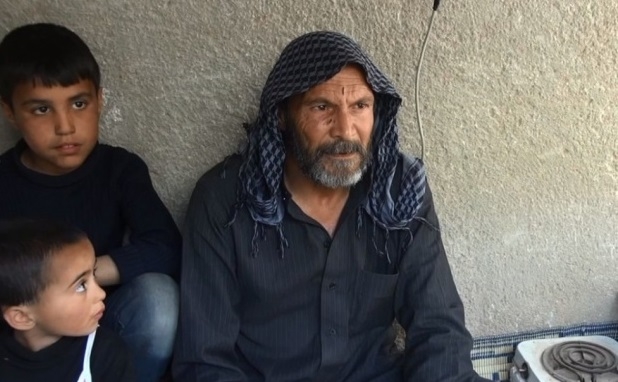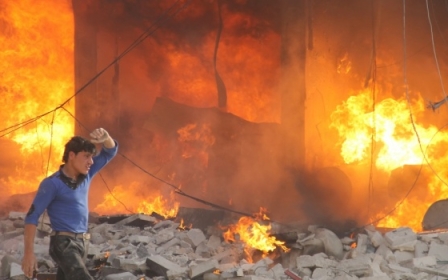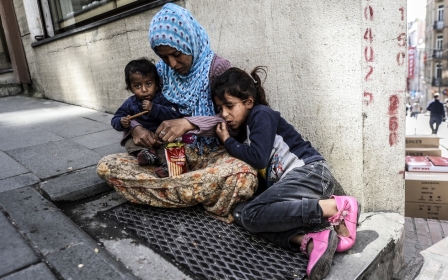In Dera’a the situation grows grim for displaced families

At the southern edge of Syria, in the province of Dera’a, thousands of displaced families have pressed into a ragged stretch of make-shift shelters, tent-filled orchards, and disused buildings hastily repurposed as family homes. They’re from Homs, Hama, Damascus, Dera’a and beyond, part of a human flood surging towards Jordan in hopes of escaping the violence of Syria’s three-year civil war.
But with this expanse of border long closed to all but the most urgent medical cases, these families have found another type of hardship: life as an internally displaced person (IDP) in a region with limited resources and scant humanitarian access.
As the war burns on, the number of IDPs in this region has ballooned. While a month ago local sources counted around 2,500 IDPs along the stretch of border that includes the towns of Tal Shihad and Naseeb, this week the same sources estimated the number had doubled. Syria’s Ministry of Foreign Affairs was reached but did not respond to request for comment by deadline.
Lama Fakih, a Syria and Lebanon researcher at Human Rights Watch, thinks this estimate sounds accurate.
“It is difficult to give figures on IDPs as we haven't had access to the area, but numbers in the range of 4,000 to 5,000 do not sound at all far-fetched,” Fakih said.
Humanitarian access, or lack thereof, is a critical factor in Dera’a’s descent into catastrophe. Omar al Hariri, a journalist with the activist-based Sham News Network, says he sees the number of IDPs increase by the day.
“The aid that goes to these camps is not coming from international organizations, but rather from unofficial organizations, mostly locals. The situation is getting worse every day because the number of displaced people is increasing due to ongoing barrel bombing in Dera’a,” al Hariri said.
It’s not just barrel bombings that are driving displaced people south. Michael Stephens, a researcher with the RUSI think tank, says Dera’a is the frontier of a battle between Saudi Arabia and the Syrian regime.
“The Saudis are changing their strategy, with a renewed offense in the region, and this could lead to a further uptick in IDPs,” Stephens said.
The result is a near-blackout for humanitarian aid in an area that desperately needs it.
“Due to security constraints, our access to Dera’a has been restricted,” said Ahmed Mohsen, an external relations officer with UNHCR’s Damascus operation. Mohsen says this means the United Nations refugee agency has had to rely on partners on the ground to deliver aid to the region. According to a document provided by UNHCR to Middle East Eye, that aid has so far this year has included nearly 18,000 family kits – mattresses, blankets, nappies, plastic sheeting and other supplies – but it has not included healthcare or the rehabilitation of collective shelters.
The support is sorely missed. In Naseeb, 55-year-old Abu Ahmad from Homs looks around and sighs.
"I could not get into Jordan,” Ahmad said. “I came here and made a tent out of rugs, plastic bags and sticks my children found, and I stayed here.”
He, his wife and their four sons have nothing to do now but wait for the border to open.
Poverty is one of the factors compounding this crisis. For many of the people sheltering here, Dera’a is quite literally the end of the line: the end of the road south, and the end of their own financial resources.
“Of all of my things, I was able to sell my automatic washing machine in order to pay for our transportation,” says Um Mohammed, a 45-year-old mother of five from Al Ghouta, near Damascus.
Her husband has been imprisoned, she said, and she and her three sons and two daughters left their home after it was damaged by aerial bombardment. Their goal was to make it to Jordan’s Za’atari refugee camp, but they ground to a halt in Dera’a.
“I've been here probably 10 days, and that’s without counting how much time I spend on the road and the humiliation,” she said. “I can’t go back home and I can’t live here. I tell you, my children and all of these people don't have anyone except God."
For those displaced families with the means, and the nerve, there is another option: passage, by way of smugglers, to Ruwaished, in the eastern, regime-held province of Swaida. The stretch of border here remains open, but the risks are enormous. The road to the crossing point is long and bumpy, and while the desert climate can be brutally hot during the day, it can be surprisingly cold at night. There’s little or no water or food. Shabiha, regime militia forces, are known to patrol the difficult terrain, and some vehicles are rumoured to have disappeared out there in the sand with entire families inside.
Despite the dangers of the journey, for many families, the alternative – living as an IDP under shelling or worse in Syria – is untenable. Groups cross into Jordan daily.
It’s not just a trickle, either: UNHCR’s representative to Jordan, Andrew Harper, regularly tweets arrival photos of groups of 400+ refugees crossing at Ruwaished. Arrivals information provided to MEE by UNHCR’s Amman office reveals that 13,895 people crossed into Jordan in March 2014, just over 4,000 of them from Dera’a. Despite the hostility of the journey, some 2,500 of these 4,000 people were under the age of 18.
Um Firas, a young mother from Homs, tried this route – and failed. She said she went as part of a larger family group of eight people, and made it as far as the border in Ruwaished, but was turned back due to questions about paperwork.
“We were smuggled,” she said. “There is no other way but to be smuggled. Al Ruwaished road is difficult, very difficult. Even though we paid money, we were still put in trucks like sheep.”
She, her husband and their young child are now three among the thousands sheltering south of Dera’a. There is no medical care for a sick child, no privacy for a young family, little food, no work, and no sense of when any of this will change. Life is in limbo, a waiting game: waiting for the border to open, and waiting for something else to go wrong. She has little bandwidth to cope if it does.
For the humanitarian organisations that want to reach people like Um Firas and her family but are unable to do so, this description comes as no surprise.
"I have not been to the camps in Dera’a so cannot comment on conditions there, but we have seen in other parts of the country, for example IDP camps along the Turkish/Syrian border that very basic supplies – medication, foodstuffs – are in desperate need and that there are concerns about health and sanitation conditions,” said Human Rights Watch’s Lama Fakih.
Among Syria’s neighbours, only Lebanon has left its borders open, and it has been rattled again and again by the war next door. Larger and arguably more stable, Jordan has thus far been immune to the spillover violence that has shaken Lebanon, despite stretching its budget and infrastructure to admit nearly 600,000 refugees and accommodate at least 100,000 of them in Za’atari refugee camp. Comparatively, Lebanon has taken in a million refugees but has not permitted any camps to be built.
On numbers alone, Jordan’s approach seems the more cautious, but it is also about to open Azraq camp, which can support an additional 130,000 refugees. Jordanian engagement with Syria’s displaced shows no signs of waning.
As the conflict continues and especially if the US- and Saudi-backed southern offensive in Syria gathers momentum, Jordan’s intelligence forces are likely to continue to closely monitor what is happening, security-wise, in the informal camps just north of its border. An emergence of jihadist activity, something Jordan has been keen to keep out of the Kingdom, would be too close to home.
Sham News Network’s Omar al Hariri was quick to point out that despite not being formal or permanent, Dera’a’s camps are run by factions of the Free Syrian Army (FSA) and are not lawless. “There are no displaced people sleeping rough in the shelters, and people in the camps are not susceptible to sexual violence or compulsory recruitment,” he said.
“It’s not at this point a security concern,” agreed RUSI’s Michael Stephens, explaining that he perceives no special risk of this space and its growing population being especially vulnerable to extremist activity or jihadist recruitment. “It’s more a question of the human rights of the people in these make-shift shelters.”
Rights that are, by the day, eroding in a war that shows no signs of ending soon.
(Additional reporting: Abo Bakr al Haj Ali)
New MEE newsletter: Jerusalem Dispatch
Sign up to get the latest insights and analysis on Israel-Palestine, alongside Turkey Unpacked and other MEE newsletters
Middle East Eye delivers independent and unrivalled coverage and analysis of the Middle East, North Africa and beyond. To learn more about republishing this content and the associated fees, please fill out this form. More about MEE can be found here.




